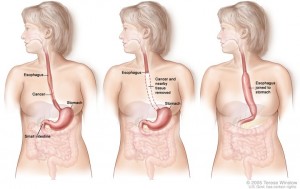Esophageal Surgery
The most common esophageal disease we treat is gastroesophageal reflux disease(heartburn, or GERD). Most of these patients have hiatal hernias, though not all, and the surgery may be referred to loosely as “hiatal hernia surgery” or as a fundoplication.
We also, however, are one of the few groups in California who treat a condition known as achalasia. For this condition the most common treatment has become a laparoscopic Heller myotmy, and we have had an extensive experience with this uncommon condition.
We also perform esophagectomy, by open surgery and also, when appropriate, by laparoscopy. We are among the first in the country to perform this complex surgery by the minimally invasive techniques of laparoscopy and thoracoscopy.
If you would like to be seen for any of these conditions, please download the following paperwork and complete it before your visit:
Laparoscopic and open Nissen Fundoplication for treatment of GERD and hiatal hernia
Laparoscopic Heller Myotomy for treatment of achalasia
- Hiatal hernia repair (download GERD information packet and GERD questionnaire above)
- Esophagectomy (removal of esophagus)
In this operation the esophagus is removed, and usually replaced by making the stomach into a long tube to span the gap. Rarely, the large intestine may be removed, instead.
Traditionally, this procedure was performed by a large incision followed by a large incision in the chest, removing one rib, and sometimes with a third incision in the neck. An alternative would be an upper abdominal incision, with the esophagus wiggled out through the abdomen, and then the stomach pulled up to the neck, where it is sewn to the esophagus in the neck.
We prefer to perform most of our esophageal resections by laparoscopy and thoracoscopy. In this procedure, the abdomen is filled with carbon dioxide, and then 5 small incisions are made, through which long, slender instruments are introduced, along with a telescope. The procedure is viewed on a TV screen. The stomach is mobilized in the abdomen, and then the patient is turned onto their side, the right lung is allowed to collapse, and the esophagus is removed in the chest. The stomach is pulled up into the chest, and sutured to the esophagus. This procedure is much less painful than the traditional techniques for removal of the esophagus, recovery is generally shorter, and it is usually our preferred approach to esophageal cancer. Few surgeons have the skills necessary to perform this procedure, however, so this procedure is not widely performed. 
When you come for your visit it is most helpful if you can bring any of the following that have been done to assess your esophageal condition:
- Endoscopy reports
- Pathology reports
- Manometry report, if done
- pH probe, if done
- Additional studies, if available, such as CT scan, endoscopic ultrasound, PET scan.
- X-ray reports and the X-rays themselves. It is unlikely that we will be satisfied with reports alone, and our time together will be used most effectively if I can review the xrays with you in clinic.

